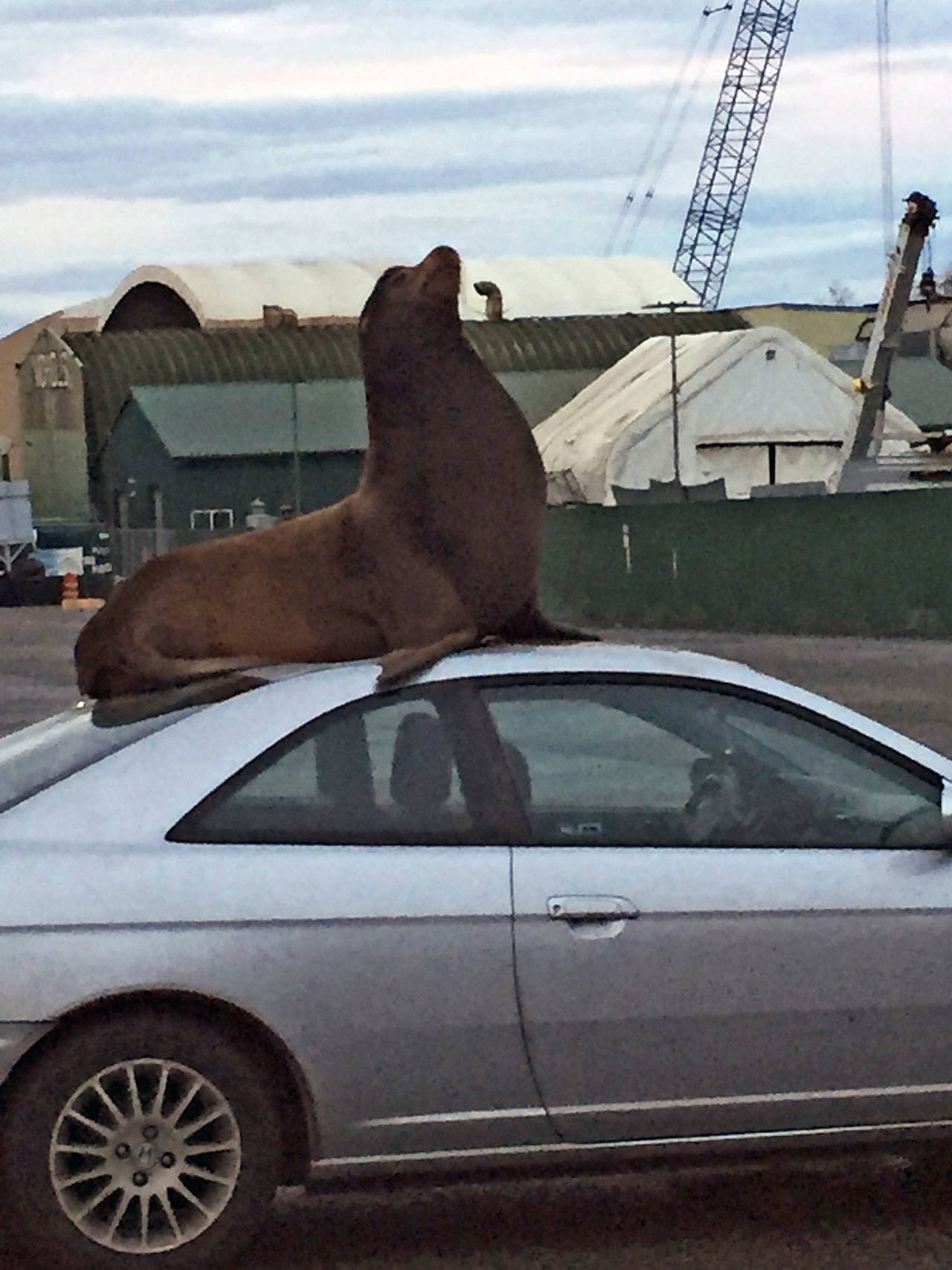A large California sea lion made national waves in Freeland on Saturday.
The 600-pound bull spent the day in and around Nichols Brothers Boat Builders’ shipyard, and more than two hours sunbathing on top of a small Honda. Stories and photos of the incident were posted on news sites across the country, including Time and Huffington Post.
“I named the sea lion ‘Civic,’ said James Fronk, a new Nichols employee who was promoted to sea lion supervisor for the day.
“I watched him all day long,” Fronk said. “He was something else.”
The animal was first discovered early Saturday morning snoozing on the company’s giant crawler inside the shipyard. Workers managed to shoo him out of active work areas, but attempts to get him out of the yard altogether were unsuccessful; an opening was made in the eastern fence, known among employees as the “South 80,” with hopes it would escape to the neighboring undeveloped property and use that as an access back to the water.
The sea lion didn’t get the hint, however, and decided instead that it would spend about two hours on top of a worker’s car.
Police monitored the situation throughout the day, and eventually worked with a small team of good Samaritans to herd the bull back to the water in Holmes Harbor. While it sounds like a simple operation, the reality was a bit more complicated. Once off the car, the animal seemed more interested in heading toward Highway 525 than the water, and police had to scramble to head him off.
“That’s when we jumped in our patrol cars,” said Deputy Grant Walker, with the Island County Sheriff’s Office.
Police used their cars as mobile roadblocks, but still struggled to keep the stubborn bull contained.
“They’re fast for how big they are,” the deputy added.
Eventually, officers and members of the public used wooden pallets and yard rakes provided by the Country Store to herd him slowly down South Cameron Road and into the water. The entire operation took about an hour.
Grant said he was relieved the animal wasn’t injured; there was a point where he thought there might actually be a collision on Highway 525. The animal seemed so resigned to crossing the road, Grant said deputies joked that it might just be easier to let him cross as he was nearly half way to Mutiny Bay already.
The herding “technique” that was employed was done in coordination with experts from the Washington Department of Fish &Wildlife and the Central Puget Sound Marine Mammal Stranding Network. Representatives from both agencies were unavailable to attend personally, but spoke with and advised police throughout the day.
“I was impressed with the assistance from Deputy Walker who I talked to a few times through the day, and with the way the incident was handled,” said Susan Berta, of the stranding network. “They kept people safe, and got the sea lion back to the water under very difficult circumstances.”
Berta said male California sea lions are common in Puget Sound and do come on the beach, but that it’s rarer for them to come so far inland. The species can suffer from domoic acid toxicity, the result of a biotoxin produced by algae that accumulates in shellfish and other foods which are consumed by sea lions and other mammals, including humans. It affects the brain and can cause sea lions to become disorientated and lethargic.
Dyanna Lambourn, a marine mammal research biologist with the Washington Department of Fish and Wildlife said that without testing it’s impossible to know for sure if the sea lion was sick. There are different levels of toxicity, acute and chronic, with the former being sudden and the later being a long-standing syndrome.
If it was suffering from chronic domoic acid toxicity, it likely would have had visible symptoms, such as weight loss. It did not, she said. She also noted that sea lions can walk over a mile inland.
“It’s not uncommon for them to go on walkabouts,” she said.
A few years ago, a California sea lion deposited herself on the upper steps of the bed and breakfast at Bush Point. She also refused to depart, leaving only at hose point. The sea lion’s corpse was later found, and its brain tested positive for domoic acid.
Berta said a sea lion in October made its presence known in Useless Bay. It was observed by a backhoe operator and hung around for about five days, she said. The stranding network is comparing images of that sea lion with the one in Freeland Saturday to see if it’s the same animal.
Berta said people should be extremely cautious around sea lions. They are fast, and can be aggressive if they feel threatened. They also carry pathogens that are harmful to humans.
To report a sea lion that’s out of the water or one that’s exhibiting strange behavior, call the stranding network’s hotline at 1-866-767-6114.



